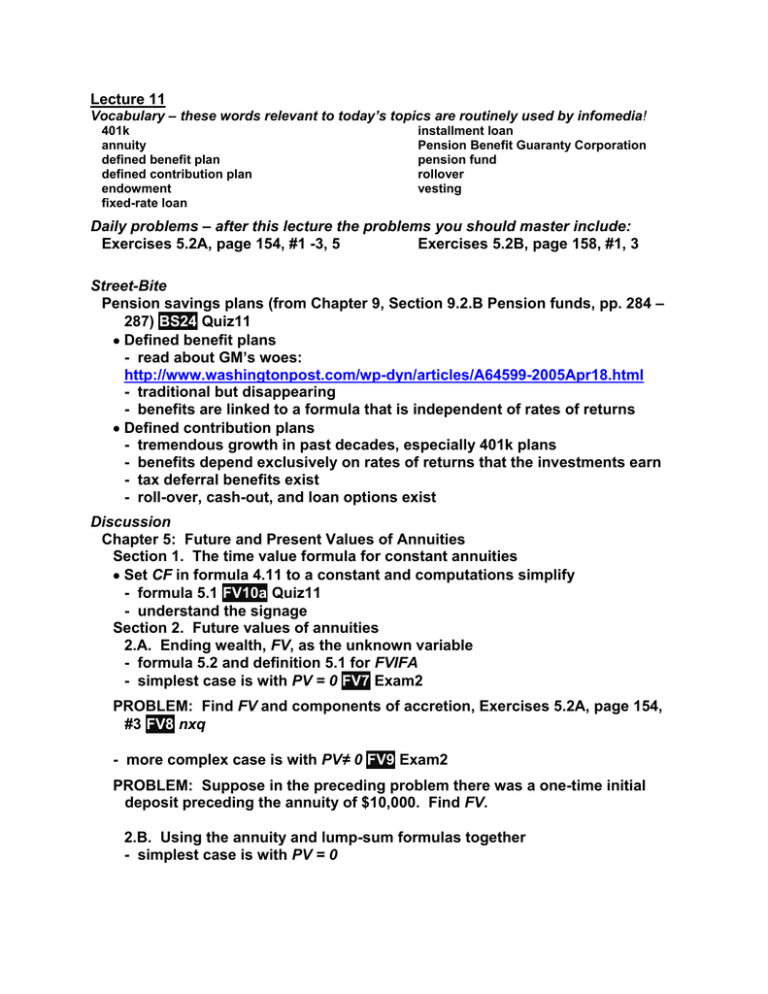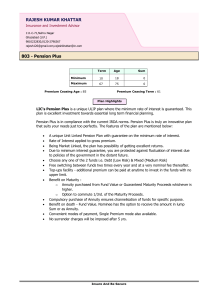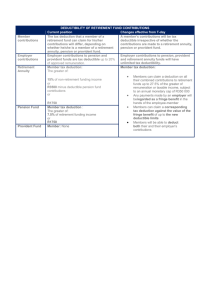
Lecture 11
Vocabulary – these words relevant to today’s topics are routinely used by infomedia!
401k
annuity
defined benefit plan
defined contribution plan
endowment
fixed-rate loan
installment loan
Pension Benefit Guaranty Corporation
pension fund
rollover
vesting
Daily problems – after this lecture the problems you should master include:
Exercises 5.2A, page 154, #1 -3, 5
Exercises 5.2B, page 158, #1, 3
Street-Bite
Pension savings plans (from Chapter 9, Section 9.2.B Pension funds, pp. 284 –
287) BS24 Quiz11
Defined benefit plans
- read about GM’s woes:
http://www.washingtonpost.com/wp-dyn/articles/A64599-2005Apr18.html
- traditional but disappearing
- benefits are linked to a formula that is independent of rates of returns
Defined contribution plans
- tremendous growth in past decades, especially 401k plans
- benefits depend exclusively on rates of returns that the investments earn
- tax deferral benefits exist
- roll-over, cash-out, and loan options exist
Discussion
Chapter 5: Future and Present Values of Annuities
Section 1. The time value formula for constant annuities
Set CF in formula 4.11 to a constant and computations simplify
- formula 5.1 FV10a Quiz11
- understand the signage
Section 2. Future values of annuities
2.A. Ending wealth, FV, as the unknown variable
- formula 5.2 and definition 5.1 for FVIFA
- simplest case is with PV = 0 FV7 Exam2
PROBLEM: Find FV and components of accretion, Exercises 5.2A, page 154,
#3 FV8 nxq
- more complex case is with PV≠ 0 FV9 Exam2
PROBLEM: Suppose in the preceding problem there was a one-time initial
deposit preceding the annuity of $10,000. Find FV.
2.B. Using the annuity and lump-sum formulas together
- simplest case is with PV = 0
PROBLEM: Find FV given an initial balance succeeded by a savings plan
(Exercises 5.2B, page 157, #3 FV12 nxq
Quiz 11 BS24 (30% DG), FV10a (30%#11), FV19a ( WG)
Videos for Lecture 11 (TOTAL: 8@69’40”)
o Pension plans (14:56)
o Constant annuity and FVIFA (10:30)
o Signage and the constant annuity (5:02)
o Find FV and total interest (5:36) [FV8]
o Lumpsum followed by annuity (10:08) [FV12]
o Find actual APR given savings surplus (8:52) [FV19a]
o FV given beginning balance (4:33) [FV5]
o Annuity sandwiched between lumpsums (10:03) [FV6]
Total assets,
all pension funds
credit market
instruments
corporate equities
mutual fund shares
other assets
1980
-1-
1985
-2-
1990
-3-
1995
-4-
2000
-5-
$882
$1,885
$3,089
$5,269
$9,043
298
581
912
1,162
1,582
276
7
301
636
11
657
877
40
1,260
2,080
327
1,700
3,936
838
2,687
TABLE 9.5 Assets of Private and Public Pension Funds, 1980 – 2000 ($bil).
Update below from http://www.census.gov/compendia/statab/2012/tables/12s1218.pdf
Lessons about the Structure of Finance. © 2014 by Thomas W. Downs. All rights reserved.
http://bama.ua.edu/~fi302/
The FLOW OF FUNDS DATA above are collected by THE FED!
There are two primary types of pension plans that an employer may offer
employees: a defined benefit plan or a defined contribution plan. The plans
differ by the type of promise that the employer makes to employees.
B1. Defined benefit retirement plans
A defined benefit plan is the traditional type of pension plan. Many of the oldest
and largest companies, such as IBM and ATT, as well as most government employers (city,
county, state, and federal agencies), enroll workers in defined benefit plans. Each pay
period the worker makes contributions (often mandatory) to the plan, and perhaps the
employer matches the contribution. The defined benefit plan promises to pay specific sums
of money to the workers when they retire. Once an employee is eligible for retirement
(eligibility often occurs when age plus years-of-service equals a specific number), then a
formula similar to this determines the retirement benefit:
monthly pension = 2.0125% x (years of service) x
(highest annual salary) 12
B2. Defined contribution retirement plans
Defined contribution plans make absolutely no promises about retirement benefits.
Instead, defined contribution plans promise the amount that the employer contributes each
pay period to the employee’s pension fund. Typically, the employee contributes a portion
of wages to the pension plan. The employer matches all or part of the contribution. With a
one-to-one match, for example, the employee may contribute 5% and the employer
contributes 5%. This represents an instantaneous doubling of employee wealth – a 100%
rate of return without any risk! Employees definitely should contribute up to the limit that
the employer matches.
Among the several types of defined contribution plans, the 401(k) plan is most
popular. Table 9.6 shows the rapid increase in number of qualified plans that employers
sponsor.
NPR DIANE REHM SHOW SAID AVERAGE PENSION ASSETS FOR A 60-YEAR OLD
USA HOUSEHOLD IN 2014 EQUALS $120,000.
Lessons about the Structure of Finance. © 2014 by Thomas W. Downs. All rights reserved.
http://bama.ua.edu/~fi302/
Number of 401(k) plans
active participants
(thousands)
in 401(k) plans
assets (billions) in 401(k)
plans
assets (billions) in all
private defined
contribution plans
1985
-129,869
1990
1995
2000
-2-3-497,614 200,813 320,000
10,339
19,548
28,061
42,000
$144
$385
$864
$1,800
$424
$713
$1,329
$2,511
TABLE 9.6 Summary of 401(k) defined contribution plans.
Update from http://www.census.gov/compendia/statab/2010/tables/10s1181.pdf
The 401(k) plan, like all defined contribution plans, shifts responsibility of financial
security away from the employer and toward the employee. The retirement benefits that
the employee receives depend on the performance of the investments. With good
investments it will be a plentiful retirement, but if things go badly the pension may be
inadequate. The employer makes no promises and bears no burden about the size of
retirement benefits with a defined contribution plan.
BS24 Pension plan attributes
Which statement most accurately describes pension plans in the USA?
a. The 401k plan is a defined benefit plan that is the most common pension plan
in the USA today
b. In a 401k plan employer contributions increase the employee's current taxable
income
c. Companies used to offer employees defined benefit plans but, as time goes
on, defined contribution plans are becoming more common
d. Two choices, A and C, are correct
e. The three A-B-C choices are all correct
Lessons about the Structure of Finance. © 2014 by Thomas W. Downs. All rights reserved.
http://bama.ua.edu/~fi302/
CHAPTER 5.4B DISCUSSES A TWO STAGE ANNUITY IN PV8 and PV3C
The book solution for the first find of PV8 shows the algebraic and calculation
solutions.
Lessons about the Structure of Finance. © 2014 by Thomas W. Downs. All rights reserved.
http://bama.ua.edu/~fi302/
FORMULA 5.1 Constant annuity time value formula
PV
CF
CF
1
1 r 1 r 2
CF
FV
N
1 r
1 rN
.
1 1 r -N
-N
FV 1 r
CF
r
Suppose you make a series of identical deposits and want to know the
ending balance. For this scenario, FV is the unknown variable. Rearrange and
isolate FV on the left-hand-side:
FV10a Find FV for simple annual plan
Family friends of yours got a tax refund of $1,600 today. Instead of spending the
money, they plan to deposit it into an account that earns 5.50% compounded
annually. They expect to receive 8 same-sized annual tax refunds and to
immediately deposit them into this account. Otherwise, they’ll leave the account
alone.
Find the account balance after their last deposit.
a. $17,110
b. $12,855
c. $14,140
d. $15,555
e. $11,686
FORMULA 5.2 Future value of a constant annuity stream
1 rN 1
FV PV 1 rN CF
r
PV 1 r CF FVIFA rate r , periods N
N
.
DEFINITION 5.1 Future value interest factor of annuities (FVIFA)
FVIFA is the future value of one dollar deposits made for N consecutive periods
that earn the periodic discount rate r:
1 r N 1 .
FVIFA r , N
r
Lessons about the Structure of Finance. © 2014 by Thomas W. Downs. All rights reserved.
http://bama.ua.edu/~fi302/
The variable signs in equation 5.2 deserve discussion. Begin with an
example in which 10 percent interest compounds annually in a savings account
for 2 years. With a beginning wealth PV of $100, and CF of $0, the ending FV
Lessons about the Structure of Finance. © 2014 by Thomas W. Downs. All rights reserved.
http://bama.ua.edu/~fi302/
2
wealth two periods later is $121 (that is, $121 = $100x1.10 ). This lump-sum
scenario is shown in the time line below:
0
1
2
PV= $100
CF= $0
CF= $0
FV= $121
Now extend the example. Suppose that $20 is withdrawn from the account at
times 1 and 2; that is, CF = $20. This annuity scenario is shown in this time line:
0
1
2
PV= $100
CF= $20
CF= $20
FV= ?
Recall that formula 5.1 (and its rearrangement in 5.2) assumes that when PV, CF,
and FV are all positive that CF represents a withdrawal, or return of cash flow.
This problem fits that description. On the right-hand-side of formula 5.2 subtract
the positive CF from the positive PV(1+r)N. How much now is the ending balance
at time 2? Substitute into equation 5.2 to find that:
1.102 1
FV $100 1.10 $20
0.10
2
= $121 $42
= $79
The $42 subtracted-out equals the future value of the withdrawal stream. The
withdrawals naturally diminish the ending balance below $121; it falls to $79.
Here are three short lessons about variable signs for FV, PV, and CF in
formula 5.1 (or any of its rearrangements shown in this chapter).
(1) Signage is simple to interpret when one of the three variables is zero. For example, if PV
equals zero because there is no beginning wealth but simply there are deposits CF and ending
wealth FV then signage is simple. Likewise in the lump-sum relation when CF is zero then the
signs on FV and PV are easy to interpret.
(2) When neither FV, PV, or CF equal zero then remember the baseline scenario that formula 5.1
exemplifies. Beginning wealth PV flows into an account, periodic CF flow out of the account
(like withdrawals), and ending wealth FV is the balance immediately after the last CF. For the
preceding scenario all variables are positive. For scenarios that reverse the flow then reverse
the sign. For example, when periodic deposits CF flow into the account assign in formula 5.1
a negative sign to CF.
Lessons about the Structure of Finance. © 2014 by Thomas W. Downs. All rights reserved.
http://bama.ua.edu/~fi302/
(3) Usually there are two approaches for signing all variables. Whatever is positive in approach 1
is negative in approach 2, and vice versa. Both approaches lead to the same correct
numerical answer. For example, the previous paragraph states that when PV and FV are
positive then periodic deposits have negative signs. An alternative approach reverses signs:
when PV and FV are both negative then assign a positive sign to periodic deposits. The
choice of signs in a problem is a relative issue.
FV7 Find FV for a simple annuity
Your parents contribute $130 monthly to a college savings plan for you that
earns 9.90% compounded monthly. The first deposit was exactly 15 years ago.
Find the account balance after today’s monthly deposit and crediting of monthly
interest.
CLUES: N=181
a. $44,595
b. $49,054
c. $59,355
d. $53,959
e. $40,541
EXERCISES 5.2A
3. Your company contributes $1,250 each quarter to your college for setting up a
scholarship fund. The account earns 6.50% compounded quarterly. The first
deposit was exactly 15 years ago and no funds have thus far been withdrawn.
Find the account balance and total amount of accumulated interest after today’s
quarterly deposit and crediting of quarterly interest. FV8
ANSWER: With first deposit 15 years ago there have been 61 total deposits (= 4 ×
15 + 1). The quarterly periodic rate is 1.625% (= 6.50% ÷ 4). Apply formula 5.2 and
find FV = $1,250 × ( 1.0162561 – 1 ) ÷ 0.01625, which equals $128,709. The total
contributed principal is $76,250 (= 61 × $1,250), which means that total interest
equals $52,459 (= $128,709 – $76,250).
FV9 Find FV given PV and withdrawal history (monthly compounding)
An account is today credited with its monthly interest thereby bringing the
account balance to $6,660 . The interest rate is 6.60% compounded monthly. You
plan to make monthly withdrawals of $55 each. The first withdrawal is in exactly
one month and the last in exactly 12 years. Find the account balance immediately
after the last withdrawal.
a. $3,516
b. $3,197
c. $2,906
d. $2,642
e. $2,402
EXERCISES 5.2B
3. Today you inherit an account with a balance of $2,200. For a while you don’t
do anything with the account but it continues to accrue interest at a rate of
10.00% compounded monthly. Exactly 10 months from today you start
withdrawing $150 monthly from the account. You make a total of 16 consecutive
monthly withdrawals. Find the account balance immediately after the last
withdrawal. FV12
ANSWER: The monthly periodic rate r is 0.833% (= 10% ÷ 12). PV initially equals
$2,200. There are 16 withdrawals, CF, equal to $150 and the 1st one occurs 10
Lessons about the Structure of Finance. © 2014 by Thomas W. Downs. All rights reserved.
http://bama.ua.edu/~fi302/
months from today, the 2nd one in 11 months, 3rd one in 12 months, …, and 16th in
25 months. Note that PV compounds for 9 months to become $2,371 (=$2,200 x
1.008339 ) exactly one period before the first annuity cash flow. Apply formula 5.2
to find FV = {$2,371 x 1.0083316 } – {$150 x (1.0083316 – 1) ÷ 0.00833}; which is
$2,707 – $2,556; which is $151. Note that both PV and CF are positive. PV,
however, increases FV whereas CF is subtracted away and decreases FV.
Lessons about the Structure of Finance. © 2014 by Thomas W. Downs. All rights reserved.
http://bama.ua.edu/~fi302/







